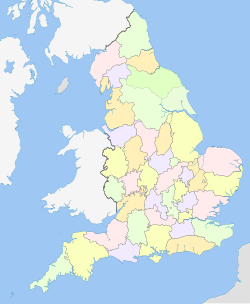
Back Condaos históricos d'Inglaterra AST Историческо графство Bulgarian Comtat històric d'Anglaterra Catalan کاونتییە مێژوویییەکانی ئینگلتەرا CKB Anglická tradiční hrabství Czech Siroedd hanesyddol Lloegr Welsh Traditionelle Grafschaften Englands German Anexo:Condados históricos de Inglaterra Spanish Ajalooline krahvkond Estonian Luettelo Englannin historiallisista kreivikunnista Finnish
| County | |
|---|---|
| |
 Counties of England in 1851 with major rivers, the ridings of Yorkshire, and the remaining exclaves shown | |
| Category | County |
| Location | England |
| Found in | Kingdom |
| Created |
|
| Number | 39 (as of 1 April 1889) |
| Possible status | |
| Populations | c. 21,000—3.4 million (1881)[1] |
| Areas | c. 94,000–3.8 million acres (15,000 km2) (1881)[1] |
| Government |
|
| Subdivisions | |
The historic counties of England are areas that were established for administration by the Normans, in many cases based on earlier kingdoms and shires created by the Angles, Saxons, Jutes, Celts and others. They are alternatively known as ancient counties,[2][3] traditional counties,[4] former counties[5][6] or simply as counties.[7] In the centuries that followed their establishment, as well as their administrative function, the counties also helped define local culture and identity.[8][9] This role continued even after the counties ceased to be used for administration after the creation of administrative counties in 1889,[10] which were themselves amended by further local government reforms in the years following.[11][12]
Unlike the partly self-governing boroughs that covered urban areas, the counties of medieval England existed primarily as a means of enforcing central government power, enabling monarchs to exercise control over local areas through their chosen representatives – originally sheriffs and later the lord-lieutenants – and their subordinate justices of the peace.[13] Counties were used initially for the administration of justice, collection of taxes and organisation of the military, and later for local government and electing parliamentary representation.[14][15] They continue to form the basis of modern local government areas in many parts of the country away from the main urban areas, although the newly created areas sometimes have considerably altered boundaries from the historic counties on which they are based.[4][16][17]
- ^ a b "Population. England and Wales. Vol. I. [Ancient] counties, 1881". Census of England and Wales 1881. Online Historical Population Reports. p. vi. Archived from the original on 16 July 2011. Retrieved 26 July 2010.
- ^ "Preliminary Report, England and Wales, 1891". Census of England and Wales 1891. Online Historical Population Reports. p. vii. Archived from the original on 16 July 2011. Retrieved 26 July 2010.
- ^ Youngs, Frederic A Jr. (1979). Guide to the Local Administrative Units of England, Vol.I: Southern England. London: Royal Historical Society. pp. xii–xiii. ISBN 0-901050-67-9.
Ancient County: Counties are geographic entities whose origins reach back into the pre-Conquest period. They were derived either from Jutish, Celtic and Anglo-Saxon kingdoms whose size made them suitable administrative units when England was unified in the tenth century, or as artificial creations formed from larger kingdoms. The number of 'shires' (the Anglo-Saxon term) or 'counties' (Norman term) varied in the medieval period, particularly in the north of England.
- ^ a b Cite error: The named reference
guidewas invoked but never defined (see the help page). - ^ "Definition of Sussex in English". Advance Dictionary. Archived from the original on 20 May 2021. Retrieved 20 May 2021.
- ^ "Suffolk". Merriam-Webster's Geographical Dictionary. Merriam-Webster. 1997. p. 1135. ISBN 0877795460. Retrieved 21 September 2013.
- ^ "Specsavers County Championship". ECB. Archived from the original on 16 April 2018. Retrieved 15 April 2018.
- ^ Bell, Bethan (20 April 2014). "Flying the county flag: The preservation of an identity". BBC News. BBC. Archived from the original on 8 May 2018. Retrieved 15 April 2018.
- ^ Worrall, Simon (22 November 2014). "Britons Feeling Rootless After Changes to England's Historic Counties". National Geographic. National Geographic Society. Archived from the original on 26 November 2014. Retrieved 15 April 2018.
- ^ Vision of Britain Archived 16 April 2017 at the Wayback Machine — Type details for ancient county. Retrieved 19 October 2006,
- ^ Chisholm, Michael (2000). Structural Reform of British Local Government: Rhetoric and Reality. Manchester University Press. p. 22. ISBN 9780719057717. Retrieved 15 April 2018.
local government 1974 reform england.
- ^ "UK Local Government – Key Dates" (PDF). Archived (PDF) from the original on 27 November 2021. Retrieved 15 April 2018.
- ^ Chandler, J. A. (2007). "Local government before 1832". Explaining Local Government: Local Government in Britain Since 1800. Manchester: Manchester University Press. p. 2. ISBN 978-0719067068.
- ^ Hackwood, Frederick William (1920). The Story of the Shire, being the Lore, History and Evolution of English County Institutions (PDF). London: Heath Cranton Limited.
- ^ Byrne, Tony (1994). Local Government in Britain. Harmondsworth: Penguin Books. ISBN 0-14-017663-2.
- ^ Central Office of Information (1996). Local Government. Aspects of Britain. London: HMSO. ISBN 0-11-702037-0.
- ^ Hampton, William (1991). Local Government and Urban Politics. London: Longman. ISBN 0-582-06204-7.